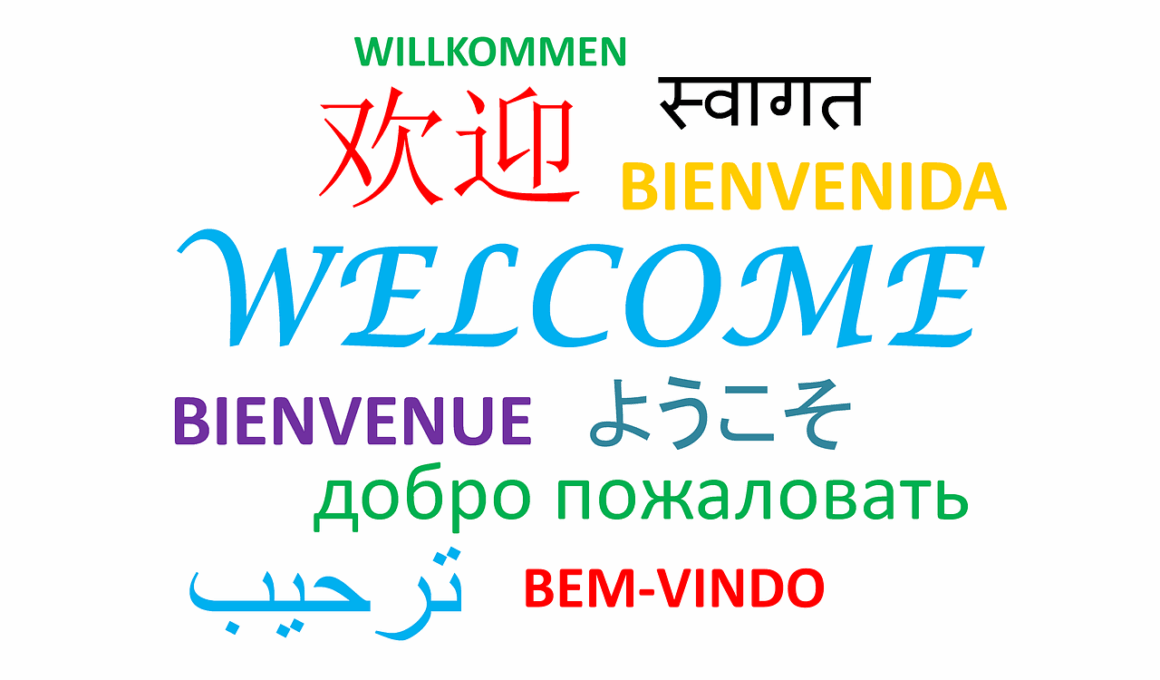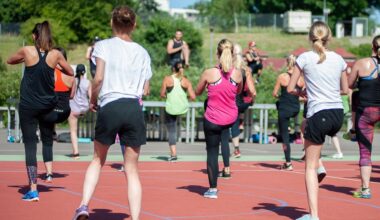Navigating Language Barriers in a Multicultural Gym Setting
Effective communication within a multicultural gym environment is crucial. Gym-goers come from various cultural backgrounds, which can lead to diverse interpretations of gym etiquette. Initially, it is essential to recognize that language barriers may hinder effective communication. Users might possess different levels of proficiency in the dominating language spoken at the gym. Consequently, it becomes vital to employ basic yet clear communication methods. Utilize non-verbal gestures, such as pointing or demonstrating, when verbal communication fails. Many individuals globally understand simple gestures. Also, using photographs or diagrams may support your communication efforts in the gym. Make a point of fostering a welcoming environment. When individuals feel comfortable, they are more likely to ask questions or seek assistance, thereby overcoming any potential communication hurdles. Simple phrases can be shared among gym members, allowing a more inclusive atmosphere. Gym managers could organize communication workshops to enhance language skills. Implementing multilingual signage may also contribute positively, reminding members of the importance of respect and openness. Overall, fostering an understanding of each other’s backgrounds is key to creating a supportive gym culture.
The significance of body language in effective gym communication cannot be overstated. Non-verbal cues often communicate feelings or intentions more directly than words. When engaging with international gym members, your body language must be positive and encouraging. To promote cooperation, maintain open body posture and frequent eye contact. Whenever possible, smile and nod to convey approachability. Significantly, adapting your gestures to align with cultural norms is beneficial too. Some cultures may perceive gestures, like thumbs up, differently. Thus, it’s important to be culturally aware and adjust accordingly. Furthermore, showing respect involves listening actively to gym members who may experience difficulty expressing themselves verbally. Allow them to complete their thoughts without interruption, and offer assistance when needed. Using an empathetic approach not only fosters goodwill but also establishes a sense of community. Emphasizing verbal affirmation, like saying “good job” or offering constructive feedback during workouts, is beneficial too. When positively reinforced, gym members feel valued, empowering them to partake in conversations. In such a diverse setting, effective communication ultimately requires a combination of body language, patience, and a genuine willingness to understand and connect.
Creating an Inclusive Atmosphere
Building a harmonious atmosphere in a multicultural gym setting hinges on inclusivity. Gym environments can become enriched through varied interactions. Therefore, it’s essential to ensure everyone feels included, fostering a sense of belonging. Regularly engage in conversations, and acknowledge every effort made by members, regardless of their proficiency in the primary spoken language. Celebrating different cultural events, like international days, can elevate the sense of community amongst gym-goers. Incorporating themed group classes based on cultural fitness trends can also enhance members’ experiences. Offering multilingual training materials or workshops is another aspect of inclusivity. Mustering the courage to ask questions exhibits a willingness to learn and understand. When members are eager to connect, it establishes a profound sense of collaboration. Be attentive to cultural customs and practices. Some individuals may prefer modest workout attire, while others may appreciate more expressive styles. Such observations can strengthen relationships, enhancing mutual respect and understanding. Additionally, consider providing translation services or apps that aid language comprehension during classes. With a well-rounded approach, everyone will appreciate their gym experience, fostering long-lasting fitness journeys together in the process.
Empowering gym staff to navigate communication challenges contributes to a cohesive atmosphere. Employees are often the primary touchpoint in the gym for members. Training staff members in cultural competency ensures they effectively manage diverse communication scenarios. Initiating workshops that promote empathy and effective communication strategies is key. Members often seek assistance in overcoming language barriers and understanding gym policies. Equipping staff with techniques to inform members politely and effectively is integral. Encouraging gym managers to prioritize hiring diverse staff can create a more relatable environment for all members. Multilingual team members could provide vital assistance to those struggling with language issues. Moreover, ensuring staff can empathize with the members they assist can positively change gym dynamics. When handling conflicts or misunderstandings, staff that understands cultural nuances will implement thoughtful resolution strategies. Additionally, fostering social events, both for members and staff, might strengthen interpersonal relationships, ultimately sharpening communication skills. In achieving such a mission, members will feel supported and accepted, irrespective of their background. A successful collaborative environment ensures a gym’s continued growth while nurturing active communication and enhancing camaraderie at every level.
Utilizing Technology for Better Communication
Integrating technology can significantly improve communication in a multicultural gym. With the growing use of smartphones, gym apps can facilitate smoother interaction. Developing a gym-specific application can allow users to communicate in their preferred language. Also, enabling messaging features to support discussions between members can enhance the sense of community. Google Translate has become a practical tool for quick interaction, allowing members to engage in conversations with ease. Additionally, consider implementing QR codes around the gym, leading to essential information translated into various languages. Fitness-related videos in multiple languages could also enhance members’ workout experiences by promoting better understanding of exercise techniques. Online tutorial platforms, like YouTube, provide excellent resources for members looking to grasp workout instructions visually. Virtual group classes may provide accessible channels for members to connect, irrespective of language proficiency. It’s crucial to keep the conversation going in various mediums for utmost inclusivity. Online forums or social media groups can encourage ongoing discussions and support among members. Ultimately, leveraging technology ensures that language barriers diminish, influencing overall gym satisfaction and success.
Feedback mechanisms serve as an effective way to enhance interactions among members in a multicultural gym. Developing an anonymous feedback system can empower members to voice concerns, suggestions, or improvements needed. Implementing surveys targeting members’ experiences helps identify pain points in communication processes. This feedback can serve as a basis for evolving communication strategies, legitimizing individual perspectives. Moreover, establishing an inclusive committee comprising members from diverse backgrounds can elevate communication approaches. The committee would provide recommendations for better engagement practices based on lived experiences. Periodically review communication methods and how they align with member feedback, adapting as necessary to address changing needs. Organizing forums or meetings where gym members can share their thoughts encourages broader engagement and deeper discussions. Being receptive to feedback fosters trust and cultivates a welcoming environment. Celebrating if and when members express their thoughts promotes future communications and strengthens camaraderie. A focus on feedback mechanisms signifies a commitment to inclusivity, ultimately enhancing the overall experience for every individual. Addressing challenges collectively contributes to a better, more appealing gym environment for everyone involved.
Conclusion: Embracing Diversity
In conclusion, navigating language barriers in a multicultural gym setting requires adaptability, understanding, and open-mindedness. When members are educated on employing effective communication strategies, language differences become lesser obstacles. Mutual respect intertwines with inclusivity, promoting a collaborative environment where everyone can thrive. As we embrace diverse backgrounds, unique perspectives on fitness can emerge while bolstering our community. By training staff, utilizing technology, and establishing feedback mechanisms, gyms can create an atmosphere conducive to effective communication. Group fitness activities that celebrate cultural diversity foster connections between members and celebrate individual and shared successes. Continued efforts in building relationships among members lead to a flourishing gym community where diversity is cherished. Ultimately, every member’s journey toward their fitness goals becomes easier and more enjoyable. The fusion of cultures not only enhances the gym experience but also encourages personal growth through shared encounters. Gym facilities that prioritize and promote such an ethos will stand out among others as supportive hubs for fitness. As we move forward, may we continue to embrace and celebrate the inherent richness that comes from our differences.
The significance of body language in effective gym communication cannot be overstated. Non-verbal cues often communicate feelings or intentions more directly than words. When engaging with international gym members, your body language must be positive and encouraging. To promote cooperation, maintain open body posture and frequent eye contact. Whenever possible, smile and nod to convey approachability. Significantly, adapting your gestures to align with cultural norms is beneficial too. Some cultures may perceive gestures, like thumbs up, differently. Thus, it’s important to be culturally aware and adjust accordingly. Furthermore, showing respect involves listening actively to gym members who may experience difficulty expressing themselves verbally. Allow them to complete their thoughts without interruption, and offer assistance when needed. Using an empathetic approach not only fosters goodwill but also establishes a sense of community. Emphasizing verbal affirmation, like saying “good job” or offering constructive feedback during workouts, is beneficial too. When positively reinforced, gym members feel valued, empowering them to partake in conversations. In such a diverse setting, effective communication ultimately requires a combination of body language, patience, and a genuine willingness to understand and connect.


